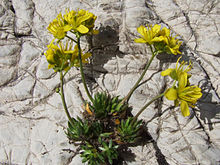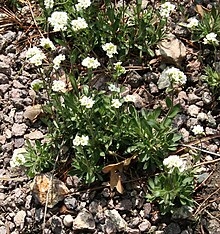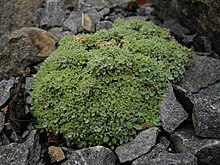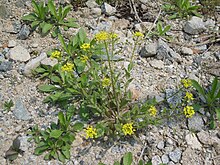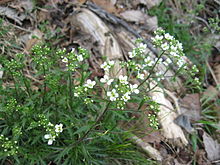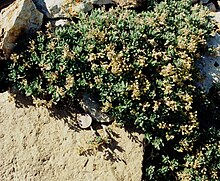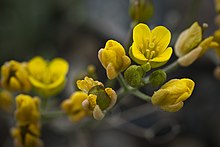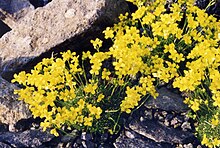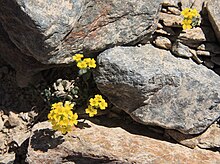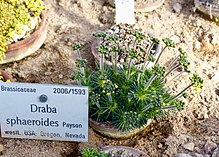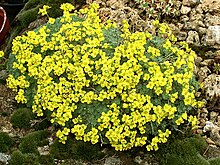-
Draba abajoensis Windham & Al-Shehbaz (Syn .: Draba spectabilis var. Glabrescens O.E.Schulz ): It was first described in 2007 and thrives at altitudes from 1900 to 3800 meters in the US states of Arizona , New Mexico and Utah .
-
Draba acaulis Boiss. : It only occurs in Turkey .
-
Draba affghanica Boiss. (Syn .: Draba affghanica var. Subtomentosa O.E.Schulz , Draba rostrata Pohle ): It grows at altitudes from 3,000 to 5,800 meters in Afghanistan , India , Pakistan and Nepal .
-
Evergreen rock florets ( Draba aizoides L. , Syn .: Draba affinis Host , Draba brachystemon DC. ): There have been two subspecies since 1995. It thrives in the mountains of southern and central Europe, from the Pyrenees , the Appennines and the Alps to the Carpathian Mountains . There are outposts in Belgium and on the coast of Wales. There are sites in Spain , France , Belgium , Germany , Austria , Poland , Ukraine , Slovakia , Switzerland , Italy , Wales , Croatia , Slovenia and Romania .
-
Draba alajica Litv. (Syn .: Draba alajica var. Lasiocarpa Pohle , Draba alajica var. Leiocarpa Pohle , Draba winterbottomii var. Stracheyi O.E.Schulz ): It occurs in southwestern Tibet , Kyrgyzstan and Tajikistan .
-
Draba albertii Regel & Schmalh. (Syn .: Draba junussovii Tomatschew ): It thrives in alpine regions at altitudes of 2500 to 3500 meters in Kazakhstan , Kyrgyzstan, Tajikistan and Uzbekistan .
-
Draba albertina Greene (Syn .: Draba crassifolia var. Albertina (Greene) OESchulz , Draba crassifolia var. Nevadensis C.L.Hitchc. , Draba deflexa Greene , Draba nitida Greene , Draba stenoloba var. Nana (OESchulz) CLHitchc. , Draba stenoloba var. Ramosa CLHitchc. ): It thrives at altitudes of 900 to 3700 meters in western North America.
-
Draba aleutica Ekman (Syn .: Draba behringii Tolmatchew ): It occurs in Alaska and Russia's Far East .
-
Alpine rock florets ( Draba alpina L. ): It is circumpolar in Greenland and Canada and occurs in Europe on Spitzbergen , in Scandinavia and in northern Russia, but not in the Alps.
-
Draba alshehbazii Klimeš & DAGerman : It wasfirst describedin 2008 from the Indian state of Jammu and Kashmir .
-
Draba altaica Bunge (Syn .: Draba rupestris var. Altaica CAMeyer, Draba altaica var. Foliosa OESchulz, Draba altaica var. Glabrescens Lipsky, Draba altaica var. Microcarpa OESchulz, Draba altaica var. Modesta (WWSmith) WTWang, Draba altaica var. Racemosa OESchulz, Draba modesta WWSmith, Draba rupestris var. Pusilla Karelin & Kirilov.): She is Russia , Kazakhstan , Kyrgyzstan , Tajikistan , Afghanistan , Pakistan (nue Chitral, Gilgit), Kashmir , India (Assam, Ladak, Panjab), Nepal , Sikkim , in Mongolia , Inner Mongolia , Tibet and in the Chinese provinces of Gansu , Qinghai , Sichuan and Yunnan .
-
Draba alticola Kom .: It occurs in Kyrgyzstan, Tajikistan and Afghanistan.
-
Draba alyssoides Kunth It occurs in Ecuador (Azuay, Cañar, Carchi, Chimborazo, Cotopaxi, Imbabura, Pichincha) and in the northern Peruvian region of Cajamarca.
-
Draba amoena O.E.Schulz :: It thrives at altitudes of 3000 to 4600 meters in India, Bhutan and Nepal.
-
Draba amplexicaulis Franch. (Syn .: Draba amplexicaulis var. Dolichocarpa O.E. Schulz , Draba yunnanensis var. Ramosa O.E.Schulz ): It thrives at altitudes of 2500 to 4700 meters in Tibet, Sichuan and Yunnan.
-
Draba anatolica A.Duran & Dinç : It wasfirst describedfrom Turkey in 2008.
-
Draba arabisans Michx. (Syn .: Draba arabisans var. Superiorensis Butters & Abbe , Draba incana var. Arabisans (Michx.) S. Watson , Draba incana var. Glabriuscula A. Gray ): It occurs in north-eastern North America.
-
Draba araratica Rupr. : It occurs in Armenia.
-
Draba arauquensis Santana : It was first described in 1995 and occurs in Colombia in Arauca and Boyacá.
-
Draba arbuscula hook. f. : This endemic thrives in the Páramo and Polylepis forests at altitudes of 3100 to 4200 meters in Venezuela only in Mérida .
-
Draba arctica J.Vahl (Syn .: Draba arctica subsp. Ostenfeldii Böcher ex Kartesz & Gandhi , Draba arctica var. Ostenfeldii Böcher ex Kartesz & Gandhi , Draba cinerea var. Arctica (J.Vahl) Pohle , Draba ostenfeldii E. Ekman , but not Draba × ostenfeldii O.E.Schulz , Draba ostenfeldii var. ovibovina E.Ekman , Draba ovibovina (E.Ekman) E.Ekman ex Gelting ): There are two subspecies in some authors. It occurs in Greenland , Svalbard and Nunavut .
-
Draba arctogena (E. Ekman) Ekman (Syn .: Draba groenlandica var. Arctogena E. Ekman , Draba cinerea var. Arctogena (E. Ekman) B. Boivin ): It thrives at altitudes of 0 to 450 meters in Greenland and in the north Canada in Nunavut as well as in the Northwest Territories.
-
Draba aretioides Kunth (Syn .: Draba aretioides var. Leiocarpa O.E. Schulz , Draba benthamiana Gilg ): It occurs only in Ecuador in the provinces of Azuay , Chimborazo , Cotopaxi , Imbabura , Pichincha and Tungurahua . It thrives in Superpáramo in the highest summit regions at altitudes of 4000 to 4500 meters. 14 sites are known.
-
Draba argentifolia Al-Shehbaz (Syn .: Draba argentea O.E.Schulz ) only occurs in the Peruvian regions of Junín and Puno.
-
Draba argyrea Rydberg : This endemic thrives at altitudes of 1000 to 3100 meters only in central Idaho .
-
Draba arida C.L. Hitchc. This endemic thrives at altitudes of 2100 to 3400 meters in the Monitor , Toiyabe and Toquima Ranges in Counties Lander and Nye in Nevada.
-
Draba arseniewi (B.Fedtsch.) Gilg ex Tolm. (Syn .: Draba alpina var. Arseniewii B.Fedtsch. , Draba darwasica var. Arseniewii (B.Fedtsch.) Pohle ): It thrives in rocky and alpine areas at altitudes of 1800 to 4000 meters in Kazakhstan and Uzbekistan.
-
Rough rock flower ( Draba aspera Bertol. , Syn .: Draba olympicoides Strobl , Draba bertolonii Nyman , Draba longirostra Schott, Nyman & Kotschy , Draba armata Schott, Nyman & Kotschy , Draba levieri Janka , Draba turgida E. Huet & A. Huet ex Ces . & al. , Draba aizoides subsp. bertolonii Nyman ): It occurs in France , Italy , Sicily and on the Balkan Peninsula .
-
Draba asprella Greene : The two varieties are endemic to northern and central Arizona.
-
Draba asterophora Payson : This endemic thrives at altitudes of 2600 to 3300 meters only in El Dorado County, California,and in the Carson Range in Washoe County in Nevada.
-
Draba aubrietioides Jafri : This endemic thrives only in Kashmir at altitudes of 1800 to 2400 meters.
-
Draba alsoeri Boiss. (Syn .: Draba linearis Boiss. , Draba longisiliqua Bornmuller non Schmalhaussen ): It occurs in Iran , Afghanistan, Kazakhstan and Tajikistan.
-
Draba aurea Vahl ex Lange (Syn .: Draba aurea var. Aureiformis (Rydb.) OESchulz , Draba aurea var. Leiocarpa (Payson & H.St.John) CLHitchc. , Draba aurea var. Luteola (Greene) OESchulz , Draba aureiformis Rydb . , Draba bakeri Greene , Draba decumbens Rydb. , Draba henneana var. maccallae (Rydb.) OESchulz , Draba luteola Greene , Draba maccallae Rydb. , Draba minganensis (Victorin) Fernald , Draba surculifera A.Nelson , Draba about A.Nelson ) : It is widespread in North America and occurs in Greenland.
-
Draba aureola S.Watson (Syn .: Draba aureola var. Paniculata L.F. Henderson ): It thrives at altitudes of 2200 to 3200 meters in the western US states from Washington to Oregon to California .
-
Draba bagmatiensis Al-Shehbaz : It wasfirst describedin 2002 from Nepal and Sikkim . It thrives at altitudes of 4100 to 4400 meters.
-
Draba baicalensis Tolm.
-
Draba bajtenovii Veselova : It wasfirst describedfrom Kazakhstan in 1997.
-
Draba barclayana Al-Shehbaz : It was first described in 1992. This endemic thrives at an altitude of around 4400 meters only in the Colombian Department de Boyacá .
-
Draba barguzinensis (ODNikif.) Baikov : It has had the rank of a species since 2005.
-
Draba bartholomewii Al-Shehbaz : It wasfirst describedin 2004 from the Chinese province of Qinghai . This endemic thrives in loose soils at the base of the valley sides at an altitude of about 4000 meters.
-
Draba beamanii Rollins : This endemic thrives on moist meadows at an altitude of around 3500 meters in Guatemala only in the Huehuetenango department .
-
Draba bellardii S.F.Blake : It thrives at altitudes of 3200 to 4900 meters in Venezuela only in Mérida and Trujillo.
-
Draba beltranii Al-Shehbaz : It wasfirst describedfrom Peru in 2009.
-
Draba bennettii G.A. Mulligan & Al-Shehbaz : It wasfirst describedin 2013 from Alaska .
-
Draba bertiscea Lakusic & Stevanovic : This endemic was first described in 1995 and is only known from a single population on Mount Prokletije in Montenegro.
-
Draba bhutanica H.Hara : It occurs in Tibet and Bhutan .
-
Draba bifurcata (CLHitchc.) Al-Shehbaz & Windham (Syn .: Draba helleriana var. Bifurcata C.L.Hitchc. ): It has been a species since 2007. This endemic thrives only in Arizona at altitudes of 1,800 to 3,600 meters.
-
Draba borealis DC. (Syn .: Draba borealis var. Maxima (Hultén) SLWelsh , Draba maxima Hultén , Draba unalaschkiana DC. ): It comes in Alaska, in Alberta, Canada, British Columbia , Nunavut , the Yukon Territory and the Northwest Territories and in Japan as well as Russia's Far East.
-
Draba boyacana Al-Shehbaz : It was first described in 1998. It occurs in the Colombian departments of Arauca and Boyacá.
-
Draba brachystylis Rydb. : This endemic thrives only in Utah at altitudes of 1700 to 3000 meters.
-
Draba brackenridgei A.Gray (Syn .: Draba cephalantha Gilg , Draba pickeringii var. Pearcei O.E. Schulz ): It occurs in Bolivia in La paz and in the Peruvian regions Ancash , Cusco , Huancavelica , Junín , La Libertad , Lima , Pasco and Region Tacna in front.
-
Draba breweri S. Watson : (Syn .: Draba breweri var. Sublaxa Jepson ): This endemic thrives at altitudes of 3100 to 4100 meters in California.
-
Draba bruce-bennettii Al-Shehbaz : It wasfirst describedin 2016 from the Yukon Territory .
-
Draba bruniifolia Steven (Syn .: Draba diversifolia Boiss. & A.Huet , Draba natolica Boiss. ): There are four subspecies that occur in Crete , Turkey, Iraq , Iran and the Caucasus .
-
Draba bryoides DC. (Syn .: Draba rigida var. Bryoides (DC.) Boiss. ): It occurs in Armenia .
-
Draba burkartiana O.E. Schulz : It thrives at altitudes of 4,000 to 4,500 meters in the Argentine provinces of Salta and Tucumán .
-
Draba burkei (CLHitchc.) Windham & Beilstein (Syn .: Draba maguirei var. Burkei CLHitchc.): She has received the status of a kind of 2004. This endemic thrives only in Utah at altitudes of 1,600 to 3,000 meters.
-
Draba cachemirica Gand. (Syn .: Draba cachemirica var. Koelzii O.E. Schulz , Draba cachemirica var. Stoliczkae O.E.Schulz , Draba korshinskyi var. Setosa Pohle ): It occurs in Tibet and Kashmir .
-
Draba cacuminum E. Ekman : There are two subspecies. This rare species occurs only in a few isolated locations in Norway and Sweden .
-
Draba cajamarcensis Al-Shehbaz : It wasfirst describedfrom Peru in 2012.
-
Draba calcicola O.E.Schulz (Syn .: Draba Aprica O.E.Schulz , Draba amplexicaulis var. Dasycarpa O.E.Schulz , Draba moupinensis var. Calcicola (OESchulz) WTWang , Draba moupinensis var. Dasycarpa O.E.Schulz ): It grows on steep cliffs and rocky slopes at elevations from 3300 to 3400 meters only in Yunnan.
-
Draba californica (Jeps.) Rollins & RAPrice (Syn .: Draba cuneifolia var. Californica Jeps. ): It has been a species since 1988. This endemic thrives at altitudes of 3200 to 4000 meters only in the White Mountains in Mono County, Californiaand adjacent Esmeralda County in Nevada.
-
Draba cana Rydb. (Syn .: Draba breweri var. Cana (Rydb.) Rollins , Draba valida Goodding ): It is widespread in North America and occurs in Greenland.
-
Draba canoensis Al-Shehbaz, Trinidad, Ed.Navarro & Rodr.-Paredes : It wasfirst describedfrom Peru in 2013.
-
Draba cantabriae (M.Laínz) M.Laínz : This endemic occurs only in northwestern Spain .
-
Draba cappadocica Boiss. & Balansa (Syn .: Draba calycosa Boiss. & Balansa ): It occurs in Turkey.
-
Draba cardaminiflora Komarov
-
Draba carnosula O.E.Schulz (Syn .: Draba howellii var. Carnosula (OESchulz) CLHitchc. ): This endemic thrives in altitudes from 2,800 to 3,100 meters in California. It is known only from a few collections from Mount Eddy in Trinity County and the north side of Mount Shasta in Siskiyou County .
-
Draba caswellii G.A.Mulligan & Al-Shehbaz : It wasfirst describedin 2013 from the Yukon Territory .
-
Draba cayouettei G.A. Mulligan & Al-Shehbaz : It wasfirst described in Quebec in 2012.
-
Draba cemileae Karaer : It wasfirst describedfrom Turkey in 2012.
-
Draba chamissonis G.Don (Syn .: Draba frigida var. Kamtschatica Ledeb. , Draba kamtschatica (Ledeb.) N.Busch , Draba lonchocarpa subsp. Kamtschatica (Ledeb.) Calder & RoyL.Taylor , Draba nivalis var. Kamtschatica (Ledeb. ) Pohle ): It occurs in Alaska, Siberia and Russia's Far East.
-
Draba cheiranthoides hook. f. : This endemic occurs only in the Colombian Department del Magdalena .
-
Draba chionophila S.F.Blake : In Venezuela this endemic occurs only in Mérida.
-
Draba cholaensis W.W.Sm. : It occurs in Tibet and Sikkim .
-
Draba cinerea Adams (Syn .: Draba arctica J.Vahl , Draba magellanica subsp. Cinerea (Adams) E. Ekman ): It is widespread in the northern hemisphere in North America in Canada as well as Alaska, Greenland, in Asia in Siberia and in Russia's Far East ; in Europe it occurs only in Norway, Finland, northern Russia, Svalbard and the Faroe Islands .
-
Draba cocuyana Al-Shehbaz : This endemic was first described in 1989. It occurs only in the Colombian Department of Boyacá .
-
Draba compacta Schott, Nyman, & Kotschy : It occurs in Albania , Bulgaria and Romania .
-
Draba confertifolia Turcz. (Syn .: Draba grandiflora Hook. & Arn. , Draba grandiflora var. Spissa O.E.Schulz ): It occurs in the Colombian Nariño and in Ecuador in the provinces of Azuay, Cañar , Chimborazo, Napo , Pastanza , Pichincha and Tungurahua.
-
Draba corrugata S.Watson (Syn .: Draba vestita Davidson ): This endemic thrives at altitudes of 2000 to 3500 meters only in the Californian counties of Los Angeles and San Bernardino .
-
Draba corymbosa DC. (Syn .: Draba kjellmanii Lid ex E. Ekman , Draba alpina var. Bellii (Holm) OESchulz , Draba alpina var. Corymbosa Durand , Draba barbata Pohle , Draba bellii Holm , Draba macrocarpa Adams , Draba vestita Davidson ): She is in Canada , Greenland, in large parts of northern to far-eastern Russia, on Svalbard and Jan Mayen .
-
Draba crassa Rydb. (Syn .: Draba chrysantha var. Crassa (Rydb) OESchulz. ): It thrives in altitudes from 2900 to 4300 meters in the US states of Colorado, Montana, New Mexico, Utah and Wyoming.
-
Draba crassifolia Graham (Syn .: Draba crassifolia var. Parryi (Rydb.) OESchulz , Draba parryi Rydb. ): It occurs in Norway, Sweden, Greenland and in North America in Canada and in the western USA.
-
Draba cretica Boiss. & Hero. : She is endemic to Crete .
-
Draba cruciata Payson : This endemic thrives at altitudes of 2500 to 3100 meters only in the Sierra Nevada in Tulare County in California.
-
Draba cryophila Cuatrec. (Syn .: Draba cheiranthoides var. Leiocarpa O.E.Schulz ): In the Colombian Magdalena and in Venezuela it occurs only in Mérida.
-
Draba cryptantha Hook. f. (Syn .: Draba chlorantha O.E.Schulz , Draba cryptantha var. Laxistellata O.E.Schulz , Draba laxistellata Gilg & Brandt ex OESchulz. , Draba weberbaueri Gilg & Muschl. ): It comes in the Peruvian regions of Ancash, Ayacucho, Cuzco, Huancavelica Region Junín and in the province of Lima.
-
Draba cuatrecasasiana J.O. Rangel & E. Santana : It thrives in the Páramo at altitudes of 3500 to 4040 meters in the Colombian departments of Cundinamarca and Meta .
-
Draba cusickii B.L.Rob. ex OESchulz (Syn .: Draba sphaeroides var. cusickii (BLRob. ex OESchulz) CLHitchc.): This endemic thrives at altitudes of 2000 to 2700 meters only in Steens Mountain in Harney County in Oregon.
-
Draba cuspidata M. Bieb. : This endemic occurs only in the Crimea .
-
Draba cuzcoensis O.E.Schulz : It occurs in Bolivia La Paz and in the Peruvian regions Ayacucho and Cuzco.
-
Draba cyclomorpha Payson (Syn .: Draba lemmonii var.cyclomorpha (Payson) OESchulz ): This endemic thrives at altitudes of 2500 to 3100 meters only in the Wallowa Mountains in Oregon.
-
Draba darwasica Lipsky : It thrives on mountain slopes at altitudes of 2200 to 4300 meters in Tajikistan.
-
Draba daviesiae (CLHitchc.) Rollins (Syn .: Draba apiculata var. Daviesiae CLHitchc. , Draba densifolia var. Daviesiae (CLHitchc.) SLWelsh & Reveal ): It has been a species since 1984. This endemic thrives at altitudes from 2700 to 2900 meters only in the Bitterroot Mountains in Ravalli County , Montana.
-
Draba dedeana Boiss. & Reut. (Syn .: Draba cantabrica Willk. , Draba mawii Hook. F. , Draba zapateri Willk. ): It occurs only in Spain.
-
Draba demareei Wiggins : This endemic thrives under pines at altitudes of 2000 to 2200 meters only in the Mexican state of Baja California .
-
Draba densifolia Nutt. (Syn .: Draba caeruleomontana Payson & H.St.John , Draba glacialis var. Pectinata S.Watson , Draba globosa var. Sphaerula (JFMacbride & Payson) OESchulz , Draba mulfordiae Payson , Draba nelsonii J.F.Macbride & Payson , Draba oligosperma var. pectinata P (S.Watson) Jepson , Draba pectinata (S.Watson) Rydberg , Draba sphaerula J.F. Macbride & Payson ): It thrives at altitudes of 800 to 3700 meters in Alberta, British Columbia and in the US states of Alaska, California , Idaho, Nevada, Oregon, Utah, Washington and Wyoming.
-
Draba depressa hook. f. (Syn .: Draba alchemilloides Gilg ): It occurs in southern Colombia in Cundinamarca, in Ecuador (Bolívar, Chimborazo, Cotopaxi, Imbabura, Napo, Pichincha, Tungurahua) and in northern Peru in the Ancash region.
-
Draba discoidea Wedd. (Syn .: Draba discoidea var. Leiocarpa O.E. Schulz , Draba discoidea var. Minor Wedd. , Draba herzogii O.E. Schulz ): It occurs in Bolivia (Cochabambe, La Paz) and in the Peruvian region of Cuzco.
-
Draba doerfleri Compet. : It occurs in Albania, Bulgaria and Macedonia .
-
Draba dolichostyla (OESchulz) Kit Tan & Stevan.
-
Dolomite rock flowers ( Draba dolomitica Buttler ): This endemic thrives only in the Austrian and Italian Alps.
-
Draba dongchuanensis Al-Shehbaz, JPYue, T.Deng & HLChen : It wasfirst describedin 2014 from Yunnan .
-
Draba dorneri Heuff. : This endemic thrives only in the Romanian Southern Carpathians .
-
Draba draboides (Maxim.) Al-Shehbaz : The new combination took place in 2004. It thrives at altitudes of 3500 to 4000 meters in Gansu and Qinghai .
-
Ice rock florets or glacier rock florets ( Draba dubia Suter , Syn .: Draba laevipes DC. , Draba tomentosa Hegi non Clairv. , Draba tomentosa Willk. & Lange , Draba dubia subsp. Nevadensis Rivas Mart. ): The two subspecies come in the south - as well as Central Europe and Morocco.
-
Draba ecuadoriana Al-Shehbaz (Syn .: Draba affinis Hook. F. Nom. Illeg.): It is only known from the type collection in Superpáramo in the Ecuadorian province of Napo.
-
Draba elata hook. f. & Thomson : It occurs in Tibet and Sikkim .
-
Draba elegans Boiss. : It only occurs in Turkey.
-
Draba elisabethae N.Busch
-
Draba ellipsoidea Hook. f. & Thomson : It occurs in Kashmir, Nepal, Sikkim, Tibet and in the Chinese provinces of Gansu, Qinghai, Sichuan and Yunnan.
-
Draba eriopoda Turcz. (Syn .: Draba eriopoda var. Kamensis Pohle , Draba eriopoda var. Sinensis Maxim. , Draba pingwuensis Z.M.Tan & SCZhou ): It is in Russia, India , Nepal , Bhutan, Sikkim, in Mongolia , in Inner Mongolia , in Tibet and in the Chinese provinces of Gansu, Hubei , Qinghai, Shaanxi , Shanxi , Sichuan and Yunnan.
-
Draba eschscholtzii Pohle & N.Busch
-
Draba extensa Wedd. : This endemic is only known from four localities in the Superpáramo in Ecuador in the Pichincha province.
-
Draba exunguiculata (OESchulz) CLHitchc. : (Syn .: Draba chrysantha var. Exunguiculata O.E.Schulz , Draba chrysantha S.Watson non K.Koch ) This endemic thrives in alpine regions at altitudes of 3600 to 4300 meters in the counties Clear Creek, El Paso, Grand and Summit in central Colorado .
-
Draba falconeri O.E. Schulz : This endemic thrives on rocky slopes at altitudes of 2600 to 3500 meters only in Kashmir.
-
Draba farsetioides Linden, Planch. & Sprague : This endemic thrives in the Páramo at altitudes of 3220 to 4300 meters in Venezuela only in Mérida.
-
Draba fedtschenkoi Gilg ex OESchulz
-
Draba Fladnizensis ( Draba fladnizensis Wulfen , Syn .: Draba fladnizensis var. Pattersonii (OESchulz) Rollins , Draba pattersonii O.E.Schulz , Draba pattersonii var. Hirticaulis O.E.Schulz , Draba wahlenbergii Hartman ) It thrives zircumpolar and hichalpinen regions. It is in northern, central and southern Europe , in Asia, Greenland, in British Columbia , Québec, Nunavut , in the Yukon Territory and in the Northwest Territories and in the US states of Alaska, Colorado, Utah, Washington and Wyoming widespread.
-
Draba franktonii G.A.Mulligan & Al-Shehbaz : It wasfirst describedfrom British Columbia in 2013.
-
Draba fuhaiensis C.H. An
-
Draba funckii (Turcz.) Al-Shehbaz (Syn .: Draba lindenii var. Funckii (Turcz.) OESchulz , Draba dendroides Linden & Planchon ): This new combination took place in 1991. This endemic thrives at altitudes of around 3300 meters in Venezuela only in Mérida .
-
Draba funiculosa Hook. f. : It thrives at altitudes from 0 to 1100 meters in Argentina (Islas Malvinas, Santa Cruz and Tierra del Fuego ) and in the Chilean region XII.
-
Draba gilliesii Hook. & Arn. (Syn .: Draba araucana Phil. , Draba azorellicola O.E.Schulz , Draba chubutensis Speg. , Draba colchaguensis Phil. , Draba davilae Phil. , Draba gilliesii var. Argentina O.E.Schulz , Draba gilliesii var. Glabrata (Gilg & Speg.) OESchulz , Draba gilliesii var. rosulata rich , Draba gilliesii var. stolonifera (Barnéoud) rich , Draba magellanica var. glabrata Gilg , Draba rosulata Phil. , Draba stolonifera Barnéoud ): It grows at altitudes from 450 to 3,900 meters in Argentina (Chubut, Mendoza, Neuquén, Río Negro) and in the Chilean regions IV, V, VI, VII, VIII, IX, X, XII and in Santiago.
-
Draba glabella Pursh (Syn .: Draba Arabist sans var. Canadensis (Brunet) Fernald & CHKnowlt. , Draba Arabist sans var. Orthocarpa Fernald & CHKnowlt. , Draba canadensis Brunet , Draba daurica DC. , Draba henneana Schltdl. , Draba dovrensis Fr. Draba hirta var. laurentiana (Fernald) B.Boivin , Draba hirta var. pycnosperma (Fernald & CHKnowlt.) B.Boivin , Draba laurentiana Fernald , Draba megasperma Fernald & CHKnowlt. , Draba norvegica var. pleiophylla Fernald , Draba pycnosperma Fernald & CHKnowlt. , Draba sornborgeri Fernald , Draba glabella Pursh var. glabella , Draba glabella var. megasperma (Fernald & CHKnowlt.) Fernald , Draba glabella var. orthocarpa (Fernald & CHKnowlt.) Fernald , Draba glabella var. pycnosperma (Fernald & CHKnowlt.) GAMulligan ) : It is found in Russia's Far East, northern Russia, Norway, Sweden, Finland, Iceland, Kazakhstan, Mongolia, Greenland, Alaska, Canada, and the northeastern United States ( Maine , Vermont , Wisconsin ) spreads.
-
Draba glacialis Adams : It occurs in Norway and in the northern part of European Russia.
-
Draba globosa Payson (Syn .: Draba apiculata C.L.Hitchcock , Draba densifolia var. Apiculata (CLHitchcock) SLWelsh , Draba densifolia var. Decipiens S.L.Welsh , Draba densifolia var. Globosa (Payson) SLWelsh ): It grows at altitudes from 2,700 to 3,900 meters in the US states of Idaho, Montana, Utah and Wyoming.
-
Draba glomerata Royle : It is found in India , Nepal , Kashmir, Pakistan , Inner Mongolia , Tibet and the Chinese provinces of Gansu and Qinghai.
-
Draba gracillima hook. f. & Thomson (Syn .: Draba granitica Handel-Mazzetti , Draba wardii W.W.Smith ): It is widespread in northwestern India, Nepal, Bhutan, Sikkim, Tibet and Yunnan.
-
Draba graminea Greene (Syn .: Draba chrysantha var. Graminea (Greene) OESchulz , Draba chrysantha var. Hirticaulis O.E.Schulz ): This endemic thrives in altitudes from 3,000 to 4,100 meters only in Colorado.
-
Draba grandis Langsd. ex DC. (Syn .: Draba greenei Pohle , Draba hatchiae G.A.Mulligan , Draba spathulata Spreng. , Draba hyperborea var. Spathulata ex DC (Schltdl..) A. Gray ex S.Watson , Draba spathulata (Schltdl. Ex DC.) Spreng. ) : It occurs in British Columbia, Alaska, on Ratmanov Island as well as the Kuril Islands and in Russia's Far East.
-
Draba grayana (Rydb.) CLHitchc. : This endemic thrives only in Colorado at altitudes of 3500 to 4000 meters.
-
Draba hallii hook. f. (Syn .: Draba camptocarpa Turcz. , Draba jamesonii Turcz. , Draba jonocalyx Turcz. ): It comes in Colombia (in Caldas, Risaralda, Tolima), in Ecuador (in the provinces of Azuay, Bolívar , Cotopaxi, Imbabura, Napo, Pastaza , Pichincha, Tungurahua) and in the Peruvian region of Cajamarca .
-
Draba hammenii Cuatrec. & Cleef : It thrives in the Páramo at altitudes of 3500 to 4600 meters in the Colombian departments of Arauca, Boyacá and Cundinamarca.
-
Draba handelii O.E.Schulz : This endemic thrives on granite rocks at altitudes of 4,000 to 4,100 meters only in northwestern Yunnan.
-
Draba haradjianii Rech. F.
-
Draba haynaldii Stur : It only occurs in Romania.
-
Draba healyi G.A. Mulligan & Al-Shehbaz : It wasfirst describedin 2013 from Alaska .
-
Draba hederifolia Coss. : The two subspecies occur only in Morocco.
-
Draba heilii Al-Shehbaz : It wasfirst describedfrom New Mexico in 2009. This endemic thrives in the alpine tundra at altitudes of about 3700 meters only in Mora County and Rio Arriba County .
-
Draba helleriana Greene (Syn .: Draba aurea var. Stylosa A.Gray , Draba helleriana var. Leiocarpa O.E.Schulz , Draba helleriana var. Neomexicana (Greene) OESchulz , Draba helleriana var. Patens (A.Heller) OESchulz , Draba helleriana var. pinetorum (Greene) OESchulz , Draba neomexicana Greene , Draba neomexicana var. robusta A.Heller , Draba pallida A.Heller , Draba patens A.Heller , Draba pinetorum Greene , Draba stylosa (A.Gray) A.Heller non Turcz. ): It occurs at altitudes of 2100 to 3600 meters in the US states of Arizona , Colorado, New Mexico and the Mexican state of Nuevo León .
-
Draba henrici Al-Shehbaz : It was first described in 2013 from New Mexico.
-
Draba heterocoma Fenzl (Syn .: Draba bruniifolia . Subsp heterocoma (Fenzl) Coode & Cullen , Draba bruniifolia . Subsp archipelagi (OESchulz) Coode & Cullen , Draba heterocoma . Subsp archipelagi (OESchulz) Buttler , Draba heterocoma . Var archipelagi O.E.Schulz ): It occurs on Karpathos and in Asia Minor .
-
Draba hidalgensis Calderón
-
Draba himachalensis Al-Shehbaz : It wasfirst describedin 2002 from the Indian state of Himachal Pradesh .
-
Draba hispanica Boiss. : The four subspecies occur in Spain, Morocco, Algeria and Tunisia.
-
Draba hispida Willd. (Syn .: Draba tridentata DC. ): It occurs in Armenia and Turkey.
-
Draba hissarica Lipsky : It thrives in rocky locations at altitudes of 3400 to 3800 meters in Tajikistan and Uzbekistan.
-
Draba hitchcockii Rollins : This endemic occurs at altitudes of 1,800 to 2,200 meters only in the Lost River Range in Butte County and Custer County in Idaho.
-
Draba hookeri Walp. : It is only known from six localities in Páramo in Ecuador in the provinces of Bolívar, Chimborazo, Cotopaxi, Napo, Pichincha and Tungurahua.
-
Hoppe-Felsenblümchen or Hoppes Felsenblümchen ( Draba hoppeana Rchb. ): It occurs in the Alps from France, Switzerland and Italy to Austria, but is absent in Germany.
-
Draba howellii S. Watson : It occurs at altitudes from 1900 to 2700 meters in the western US states of California and Oregon.
-
Draba huetii Boiss. : It occurs in Southwest Asia, Kazakhstan, Kyrgyzstan, Tajikistan, Turkmenistan, Uzbekistan and Xinjiang .
-
Draba humillima O.E.Schulz : It occurs in Tibet and Sikkim .
-
Draba imbricata C.A.Mey. (Syn .: Draba bryoides var. Imbricata (CAMey.) Burch. )
-
Draba imeretica (Rupr.) Rupr. It occurs from Turkey to Transcaucasia .
-
Draba implexa Rollins
-
Gray rock flower ( Draba incana L. , Syn .: Draba bernensis Moritzi , Draba confusa Ehrh. , Draba contorta Ehrh. , Draba glabella Richards. , Draba ledebourii Rouy et Fouc. , Drabella incana Bub. ) This species is common in the Arctic-Alpine region Canadian Manitoba , New Brunswick / Nouveau-Brunswick , Newfoundland and Labrador , Ontario , Prince Edward Island , Québec and in the US states of Michigan , Minnesota and Greenland and in northern and central Europe .
-
Draba incerta Payson (Syn .: Draba exalata E. Ekman , Draba incerta var. Laevicapsula (Payson) Payson & H.St. John , Draba laevicapsula Payson ): It comes in two varieties at altitudes from 0 to 3300 meters in Alberta, Canada, British Columbia , the Yukon Territory as well as Québec and the US states Alaska, Colorado, Idaho, Montana, Nevada, Utah, Washington and Wyoming.
-
Draba incompta Steven
-
Draba incrassata (Rollins) Rollins & RAPrice : This endemic occurs at altitudes of 2500 to 3500 meters only in the Sweetwater Mountains in Mono County in California.
-
Draba inexpectata S.L.Welsh : It wasfirst describedin 2003 from Utah . This endemic is only known from altitudes of 3100 to 3700 meters in the Uinta Mountains in Summit County .
-
Draba inquisiviana Al-Shehbaz : It was first described in 1994. It thrives at altitudes of 4500 to 5000 meters in Bolivia in the departments of La Paz and Oruro .
-
Draba insularis Pissjauk. non goodd. 1940 : This endemic occurs on the island of Lambin and some neighboring islands in the Kandalaksha Bay of the White Sea.
-
Draba involucrata W.W.Sm. (Syn .: Draba alpina var. Involucrata W.W.Sm. , Draba alpina var. Leiophylla Franch. , Draba involucrata var. Lasiocarpa W.T.Wang ): It occurs at altitudes of 3300 to 5100 meters in eastern Tibet and Sichuan and Yunnan.
-
Draba jaegeri Munz & IMJohnst. : This endemic occurs at altitudes of 2900 to 3600 meters only in the Charleston Mountains in Clark County , Nevada.
-
Draba japonica Maxim.
-
Draba jiulongensis Al-Shehbaz : It wasfirst describedin 2012 from Sichuan .
-
Draba jorullensis Kunth
-
Draba jucunda W.W.Sm. : It occurs at altitudes of 3400 to 4600 meters in southeastern Tibet and northwestern Yunnan.
-
Draba juvenilis Kom. (Syn .: Draba hirta var. Tenella Eastwood , Draba kananaskis G.A.Mulligan , Draba longipes Raup ): it is in Alberta, British Columbia , the Yukon Territory and the Northwest Territories, Alaska and Siberia and Russia Far East common.
-
Draba kassii S.L.Welsh : This endemic occurs at altitudes of 2100 to 2600 meters only in the Deep Creek Mountains in the counties Juab and Tooele in Utah.
-
Draba kitadakensis Koidz.
-
Draba kluanei G.A.Mulligan : It is known only from the Typusaufsammlung from an altitude of about meters from the Kluane National Park in southwest Yukon Territory.
-
Draba kodarica O.D. Nikif.
-
Draba koeiei Rech. F.
-
Draba kongboiana Al-Shehbaz : It was first described from Tibet in 2002.
-
Draba korabensis Jáv. : It occurs in Serbia, Bulgaria, Albania and Macedonia.
-
Draba korshinskyi Pohle (Syn .: Draba alpina var. Korshinskyi O.Fedtschenko ) It occurs in Afghanistan, Kashmir, Pakistan, Tajikistan, Tibet and Xinjiang.
-
Transylvanian rock flowers ( Draba kotschyi Stur ) It occurs in Romania.
-
Draba kuemmerlei Stevan. & D.Lakušić
-
Draba kuramensis Junussov
-
Draba kusnetzowii (Turcz.) Hayek
-
Draba lacaitae Boiss. (Syn .: Draba erostra Halácsy ): It occurs in Greece , Macedonia and Albania .
-
Draba laconica Stevan. & Kit Tan : It wasfirst described in Greece in 2002.
-
Lapland rock flower ( Draba lactea Adams , Syn .: Draba allenii Fernald , Draba boecheri Gjaerevoll & Ryvarden , Draba fernaldiana Polunin ): It is circumpolar in the northern hemisphere and occurs in Northern Europe, Siberia, Russia's Far East, Greenland, Iceland and in northern North America in front.
-
Engadin rock flowers ( Draba ladina Braun-Blanq. ): It is endemic to the Eastern Swiss Alps.
-
Draba ladygini Pohle (Syn .: Draba incana var. Flaccida Maxim. , Draba incana var. Microphylla W.W.Smith , Draba lanceolata var. Chingii O.E.Schulz , Draba lanceolata var. Latifolia O.E.Schulz ): It is at altitudes from 2,100 to 4,700 meters in China spread.
-
Draba laegaardii Al-Shehbaz : It wasfirst describedin 2015 from the Ecuadorian Cotopaxi .
-
Draba lanceolata Royle (Syn .: Draba lanceolata var. Brachycarpa O.E.Schulz , Draba lanceolata var. Leiocarpa O.E.Schulz , Draba lanceolata var. Sonamargensis O.E.Schulz , Draba nichanaica O.E.Schulz , Draba stylaris var. Leiocarpa L.L.Lou & TYCheo ): She is in Russia, Kazakhstan , Kyrgyzstan , Tajikistan , Uzbekistan , Afghanistan , India, Kashmir, Pakistan, Sikkim, Tibet and in the Chinese provinces of Gansu, Qinghai and Xinjiang.
-
Draba lapaziana Al-Shehbaz : It was first described in 1994. It occurs in the Bolivian department of La Paz and in the Peruvian region of Peru Lima.
-
Carpathian Whitlowgrass ( Draba lasiocarpa Rochel non Adams , Syn .: Draba aizoon Wahlenb. , Draba athoa (Griseb) Boiss.. , Draba boueana O.E.Schulz , Draba scardica (Griseb) Degen & Dörfl.. ): It is used in Austria , Hungary , in Slovakia , Slovenia , Serbia , Bosnia and Herzegovina , Croatia , Montenegro , Bulgaria , Romania , Albania , Macedonia and Greece.
-
Draba lasiophylla Royle (Syn .: Draba glomerata var. Leiocarpa Pampanini , Draba ladyginii var. Trichocarpa O.E.Schulz , Draba lasiophylla . Var leiocarpa (Pampanini) OESchulz , Draba lasiophylla . Var royleana Pohle , Draba torticarpa L.L.Lou & TYCheo ): She is in Kazakhstan, Kyrgyzstan, Tajikistan, Turkmenistan, Uzbekistan, India, Kashmir, Nepal, Bhutan, Sikkim, Tibet and in the Chinese provinces of Gansu, Hubei , Qinghai, Shaanxi, Sichuan and Xinjiang.
-
Draba lemmonii S.Watson This endemic thrives at altitudes of 3000 to 4000 meters in the alpine altitude range of the Sierra Nevada in California.
-
Draba lichiangensis W.W.Sm. (Syn .: Draba daochengensis W.T.Wang , Draba hicksii Grierson , Draba lichiangensis var. Microcarpa O.E.Schulz , Draba lichiangensis var. Trichocarpa O.E.Schulz ): It comes Bhutan, Nepal, Tibet and the Chinese provinces of Qinghai, Sichuan and the northwestern Yunnan ago .
-
Draba lindenii (Hook.) Planch.
-
Draba linearifolia L.L. Louis & TYCheo : It is only known from the collection of types on shady mountain slopes at altitudes of 3600 to 4000 meters in Tibet.
-
Draba lipskyi Tolm.
-
Draba litamo L. Uribe
-
Draba loayzana Al-Shehbaz : It was first described in 1994. It thrives at altitudes from 4400 to 4700 in the Bolivian province of La Paz and in the northern Argentine provinces of Jujuy , Catamarca and Salta .
-
Draba loiseleurii Boiss. : She is endemic to Corsica .
-
Draba lonchocarpa Rydb. (Syn .: Draba nivalis var. Elongata S.Watson , Draba lonchocarpa var. Denudata O.E.Schulz , Draba lonchocarpa var. Exigua O.E.Schulz , Draba lonchocarpa var. Semitonsa Payson & H.St.John , Draba lonchocarpa var. Thompsonii (CLHitchcock) Rollins , Draba lonchocarpa . var vestita O.E.Schulz , Draba nivalis var. denudata (OESchulz) CLHitchcock , Draba nivalis var. exigua (OESchulz) CLHitchcock , Draba nivalis subsp. lonchocarpa (Rydb.) Hultén , Draba nivalis var. thompsonii C.L.Hitchcock ): It is common in Alberta, British Columbia , the Yukon Territory, as well as the Northwest Territories, Alaska, California, Colorado, Idaho, Montana, Nevada, Oregon, Utah, Washington, Wyoming and Siberia, and Russia's Far East.
-
Draba longiciliata Al-Shehbaz & Sklenář : It wasfirst describedfrom Ecuador in 2010.
-
Draba longisiliqua narrow . ex Akinfiew
-
Draba longisquamosa O.E.Schulz This endemic thrives at altitudes of 3000 to 3900 meters only in the southern Sierra Nevada only in the Californian counties Fresno , Inyo and Tulare .
-
Draba ludlowiana Jafri
-
Draba lutescens Coss. : It occurs in Morocco, Algeria and Spain.
-
Draba macbeathiana Al-Shehbaz : It wasfirst describedin 2002 from Nepal .
-
Draba macleanii Hook. f. (Syn .: Draba atacamensis Gilg ex Gilg & Muschl. ): It occurs in Argentina (Catamarca, Jujuy, La Rioja, Tucumán), in Bolivia (La Paz), in Chile (Región I) and in Peru (Ancash, Lima, Junín, Tacna).
-
Draba macounii O.E. Schulz It thrives at altitudes of 700 to 2800 meters in western North America in Alberta, British Columbia , in the Yukon Territory, in Alaska and Montana.
-
Draba magadanensis Berkut. & APKhokhr.
-
Draba magellanica Lam.
-
Draba maguirei C.L. Hitchc. This endemic thrives only in the Bear River Range in Cache County , Utah, at altitudes of 1,600 to 2900 meters.
-
Draba majae Berkut. & APKhokhr.
-
Draba malpighiacea Windham & Al-Shehbaz : It was first described in 2007. This endemic thrives at altitudes of 3000 to 3500 meters only in the Counties Hinsdale , La Plata and Montezuma in Colorado.
-
Draba matangensis O.E.Schulz : It grows on rocky slopes at elevations from 3,600 to 5,100 meters in Tibet and Sichuan.
-
Draba matthioloides Gilg & OESchulz : There have been two subspecies since 1991. They occur in the Peruvian regions of Ancash and La Libertad.
-
Draba melanopus Kom . : It occurs in Kazakhstan, Kyrgyzstan, Tajikistan, Afghanistan, Pakistan and Xinjiang.
-
Draba meskhetica L.C. Khintibidze : This endemic is only known from one site in the mountain forest in the upper montane altitude level in the headwaters of the Uravelistskali in Georgia .
-
Draba micropetala hook. : It is common in Greenland, Nunavut , Canada,as well as the Northwest Territories , Alaska and Svalbard, Siberia and Russia's Far East.
-
Draba mieheorum Al-Shehbaz : It wasfirst describedfrom Tibet in 2004and thrives at altitudes of around 4,300 meters.
-
Draba mingrelica Shishk. : This endemic thrives only in the alpine altitudes at isolated sites in Georgia .
-
Draba minima Steud.
-
Draba mogollonica Greene : It thrives at altitudes of 1500 to 2300 meters in the US states of Arizona and New Mexico.
-
Draba mollissima Steven
-
Draba Mongolica Turcz. (Syn .: Draba incana var. Mongolica (Turcz.) Regel , Draba mongolica var. Chinensis Pohle , Draba mongolica var. Elongata Pohle , Draba mongolica var. Trichocarpa O.E. Schulz , Draba mongolica var. Turczaninoviana Pohle ): She comes in Russia, in Mongolia, Inner Mongolia and the Chinese provinces of Gansu, Hebei, Heilongjiang , Jilin , Qinghai , Shaanxi, Shanxi, Sichuan and Xinjiang.
-
Draba monoensis Rollins & RAPrice : This endemic thrives at altitudes of 3600 to 4000 meters only in California's Mono County in the White Mountains.
-
Draba montbretiana Sommier & Levier : It only occurs in Turkey .
-
Draba mulliganii Al-Shehbaz : It was first described in 2009. It thrives only in Alaska at altitudes of 300 to 1,600 meters.
-
Draba murrayi G.A.Mulligan : It thrives at altitudes of 150 to 900 meters in the Yukon Territory and Alaska.
-
Draba nana Stapf : It only occurs in Turkey.
-
Draba narmanensis Yıld. : It was first described from Turkey in 2000. It is only known from the type location in northeastern Anatolia .
-
Hain Whitlowgrass or bush Whitlowgrass ( Draba nemorosa L. , Syn .: Draba Dictyota Greene , Draba nemoralis Ehrh. , Draba nemorosa L. var. Nemorosa , Draba nemorosa var. Leiocarpa Lindblom , Draba nemorosa var. Brevisilicula Zapalowicz , Draba nemorosa var . hebecarpa Lindblom ) It is widespread in the northern hemisphere in Eurasia and North America. For example, she is a neophyte in Australia.
-
Draba nipponica Makino
-
Snow rock florets or Arctic rock florets ( Draba nivalis Lilj. ): It is circumpolar in the northern hemisphere in Greenland and Iceland, in Alberta , British Columbia , Manitoba , Newfoundland , Nunavut, Ontario , Québec , in the Yukon Territory and in the Northwest Territories, widespread in Alaska and northern and western Sweden , Norway (including Svalbard), Finland , northern Siberia, and Russia's Far East.
-
Draba nivicola rose
-
Norwegian rock flower or Norwegian rock flower ( Draba norvegica Gunnerus , Syn .: Draba rupestris W.T. Aiton , Draba rupestris R.Br. , Draba clivicola Fernald , Draba hirta var. Norvegica (Gunnerus) Liljeblad , Draba norvegica var. Clivicola (Fernald) B.Boivin , Draba norvegica var. Hebecarpa (Lindblom) OESchulz , Draba scandinavica var. Hebecarpa Lindblom , Draba trichella Fries ): It occurs in Greenland, Iceland , in the Canadian Newfoundland and Labrador , Nova Scotia , Québec and in the Northwest Territories, in Scotland , Sweden , Norway , Finland and northern Russia .
-
Draba novolympica Payson & H.St.John : (Syn .: Draba barbata var. Treleasei O.E.Schulz , Daraba paysonii var. Treleasei (OESchulz) CLHitchc. ) It thrives at altitudes of 1500 to 3700 meters in Alberta, British Columbia and in the US states of California, Idaho, Montana, Nevada, Oregon, Utah, Washington and Wyoming.
-
Draba nuda (Bél.) Al-Shehbaz & M.Koch (Syn .: Arabis nuda Bél. , Drabopsis nuda (Bél.) Stapf , Drabopsis verna K.Koch , Sisymbrium nudum (Bél.) Boiss. ): The new combination took place in 2003 It occurs in Armenia, Crete, Karpathos, Kasos and Gavdhos Turkey, Afghanistan, Iran, Iraq, Kazakhstan, Kyrgyzstan, Tajikistan, Turkmenistan, Uzbekistan, India, Kashmir, Pakistan (Baluchistan, Chitral, Kalat, Swat).
-
Draba nylamensis Al-Shehbaz : It was first described from Tibet in 2002.
-
Draba oariocarpa O.E.Schulz
-
Draba oblongata DC. : It occurs in Siberia as well as in Russia's Far East, in Greenland, Alaska and in northern Canada (only Northwest Territories and Nunavut).
-
Draba obovata Benth. : This endemic is only known from six localities in Páramo in Ecuador in the provinces of Napo and Pichincha.
-
Draba ochroleuca Bunge : It occurs in the northern part of European Russia and in northern Asia.
-
Draba ochropetala O.E.Schulz :: This endemic thrives at altitudes of 4050 to 4600 meters in the Páramo only in the Peruvian region of La Libertad.
-
Draba ogilviensis Hultén : It thrives at altitudes from 900 to 2200 meters in Alaska, Yukon Territory and the Northwest Territories .
-
Draba × okamotoi Ohwi
-
Draba olgae Regel & Schmalh. (Syn .: Draba olgae var. Chitralensis O.E. Schulz , Draba pakistanica Jafri ): It occurs in Kyrgyzstan, Tajikistan, Pakistan and Xinjiang.
-
Draba oligosperma hook. (Syn .: Draba calcifuga Lesica , Draba oligosperma var. Andina Nutt. , Draba oligosperma var. Leiocarpa O.E.Schulz , Draba oligosperma var. Microcarpa Blank. , Draba oligosperma var. Saximontana (A.Nelson) OESchulz , Draba oligosperma subsp. Subsessilis ( S.Watson) AEMurray , Draba oligosperma var. Subsessilis (S.Watson) OESchulz , Draba saximontana A.Nelson , Draba subsessilis S.Watson ): It thrives at altitudes of 200 to 3900 meters in western North America in Alberta, British Columbia, Nunavut, Yukon Territory and the Northwest Territories and the US states of Alaska, California, Colorado, Idaho, Montana, Nevada, Oregon and Wyoming.
-
Draba oreades Schrenk (Syn .: Draba algida var. Brachycarpa Bunge , Draba alpicola Klotzsch , Draba alpina var. Rigida Franch. , Draba kizylarti (Korshinsky) N.Busch , Draba oreades var. Ciliolata O.E.Schulz , Draba oreades var. Commutata (Regel ) OESchulz , Draba oreades var. dasycarpa O.E.Schulz , Draba oreades var. depauperata O.E.Schulz , Draba oreades var. estylosa O.E.Schulz , Draba oreades var. glabrescens O.E.Schulz , Draba oreades var. occulata O.E.Schulz , Draba oreades var. pulvinata O.E.Schulz , Draba oreades var. racemosa O.E.Schulz , Draba oreades var. tafelii O.E.Schulz , Draba pilosa var. commutata rule , Draba pilosa var. oreades (Schrenk) rule , Draba qinghaiensis L.L.Lou , Draba rockii O.E.Schulz , Draba tianschanica Pohle , Pseudobraya kizylarti Korshinsky ): She is in Russia, Kazakhstan, Kyrgyzstan, Tajikistan, India, Kashmir, Pakistan, Bhutan, Sikkim, Mongolia, Inner Mongolia, Tibet, Xinjiang and the Chinese provinces of Gansu, Qin ghai, Shaanxi, Sichuan and Yunnan.
-
Draba oreadum Maire : The two subspecies occur in Morocco.
-
Draba oreibata J.F. Macbr . & Payson : It thrives only in Idaho at altitudes of 1,800 to 2,700 meters.
-
Draba oreodoxa W.W.Sm. (Syn .: Draba dolichotricha W.T.Wang , Draba ludingensis W.T.Wang ): It thrives at altitudes of 3800 to 4800 meters in Sichuan and Yunnan.
-
Draba orientalis Karabacak & Behçet : It was first described from Turkey in 2009.
-
Draba ossetica (Rupr.) Sommier & Levier (Syn .: Draba mollissima var. Ossetica Rupr. )
-
Draba oxycarpa Boiss. (Syn .: Draba alpina var. Oxycarpa (Sommerfelt) Th. Fries , Draba gredinii E. Ekman ): It occurs in Norway, Sweden, Iceland, Svalbard and Greenland.
-
Tauern rock flowers or Pacher rock flowers ( Draba pacheri Stur , Syn .: Draba norica Widder ): It occurs only in Austria and Slovakia .
-
Draba pachythyrsa Triana & Planch.
-
Draba palanderiana Kjellm. It occurs in northern Russia (Siberia and Russia's Far East), Alaska and in the northern Canadian Yukon Territory and Nunavut.
-
Draba pamirica Pohle
-
Draba pamplorrensis Planch. & Linden
-
Draba parnassica Boiss. & Hero. : It occurs in Greece.
-
Draba parviflora O.E.Schulz (Syn .: Draba subamplexicaulis . Var hirsutifolia Pohle ): It is common in Russia, Kazakhstan, Kyrgyzstan, Tajikistan, Xinjiang and the Chinese provinces of Gansu and Qinghai.
-
Draba pauciflora R.Br. (Syn .: Draba adamsii Ledeb. ): It occurs in Spitzbergen, in northern Russia, in Greenland, Alaska and in the northern Canadian Yukon Territory as well as Nunavut.
-
Draba paucifructa Clokey & CLHitchc. This endemic thrives only in the Charleston Mountains in Clark County , Nevada, at altitudes of 2600 to 3500 meters.
-
Draba paysonii J.F. Macbr . : It only thrives at altitudes of 1,800 to 3,500 meters in southwest Montana and northwest Wyoming.
-
Draba pectinipila Rollins : It thrives at altitudes of 1700 to 2400 meters in the US states of Colorado, Montana , Utah and Wyoming.
-
Draba pedicellata (Rollins & RAPrice) Windham (Syn .: Draba cusickii . Var pedicellata Rollins & RAPrice , Draba pedicellata var. Wheelerensis N.H.Holmgren ): She has received the status of a kind of 2004. It thrives at altitudes of 2,300 to 3,800 meters only in northeastern Nevada and northwestern Utah.
-
Draba pennell-hazenii O.E.Schulz
-
Draba pennellii Rollins : This endemic thrives at altitudes of 1900 to 3500 meters only in White Pine County in east-central Nevada.
-
Draba peruviana O.E.Schulz (Syn .: Draba pavonii Gilg ): This endemic occurs in northern Peru only in the Huanuco region.
-
Draba petrophila Greene This endemic thrives at altitudes of 1200 to 2800 meters only in the counties of Cochise , Pima and Santa Cruz in southeastern Arizona.
-
Draba physocarpa Kom. It thrives at altitudes of 0 to 500 meters in the US states of Arizona , Arkansas , Idaho , Louisiana , Oklahoma , Oregon , Texas and Washington .
-
Draba pickeringii A.Gray It occurs in the Peruvian regions of Lima and Pasco.
-
Draba pilosa Adams ex DC. It occurs in the Canadian Yukon Territory, Nunavut, as well as in the Northwest Territories, the US state of Alaska, in the northeastern part of Russia's Far East and in northern Siberia.
-
Draba podolica (Better) Rupr. It occurs in Moldova, Romania, Ukraine and Russia.
-
Draba pohlei Tolm.
-
Draba poluniniana Al-Shehbaz : It was first described in 2004 from Nepal.
-
Draba polyphylla O.E. Schulz : It occurs in Bhutan, Nepal, Sikkim, Tibet and Yunnan.
-
Draba polytricha Ledeb.
-
Draba porsildii G.A.Mulligan : It thrives in altitudes from 600 to 3000 meters in the Canadian Alberta and Yukon Territory and in the US states Alaska, Montana and Wyoming .
-
Draba praealta Greene : It is found in Alberta, British Columbia, the Yukon Territory, Canada and the Northwest Territories, in the US states of California , Idaho , Montana, Nevada , Oregon , Washington and Wyoming and on the Chukchi in Russia's Far East Peninsula in front.
-
Draba prozorovskii Tolm.
-
Draba pseudocheiranthoides Al-Shehbaz
-
Draba pseudonivalis N.Busch
-
Draba pterosperma Payson : This endemic thrives at altitudes of 1500 to 2500 meters only in the Marble Mountains in Siskiyou County in northern California.
-
Draba pulchella Willd. ex DC.
-
Draba pulcherrima Gilg : This endemic occurs only in the Ecuadorian province of Chimborazo.
-
Draba pulvinata Turcz. : There are two subspecies.
-
Draba punoensis Al-Shehbaz, Ed.Navarro, Trinidad & A.Cano : It wasfirst describedfrom Peru in 2013.
-
Draba pusilla F. Phil. ex Phil.
-
Draba puvirnituqii G.A.Mulligan & Al-Shehbaz : It wasfirst describedin 2013 from Quebec, Canada.
-
Draba pycnophylla Turcz. : It occurs in Colombia (Caldas, Narino) and in Ecuador (in the provinces of Carchi , Imbagura, Pichincha, Tungurahuaprovinces).
-
Draba pycnosperma Fernald & CHKnowlt.
-
Draba pygmaea Turcz. ex N.Busch
-
Draba radicans Royle
-
Draba ramosissima Desv. : It thrives at altitudes of 0 to 1,100 meters in the eastern US states of Kentucky , Maryland , North Carolina , Tennessee , Virginia , West Virginia, and Washington DC
-
Draba ramulosa Rollins : This endemic thrives at altitudes of 3300 to 3600 meters only in the Tushar Mountains in south-central Utah .
-
Draba rectifructa C.L. Hitchc . (Syn .: Draba montana S.Watson non Bergeret ): It thrives at altitudes of 1,800 to 3,200 meters in the US states of Arizona , Colorado, New Mexico and Utah.
-
Draba remotiflora O.E.Schulz : It is only known from the type collection from an altitude of about 4600 meters in Sichuan.
-
Draba rigida Willd. It occurs in Turkey.
-
Draba ritacuvana Al-Shehbaz : It was first described from Colombia in 1997.
-
Draba rositae Santana & JORangel
-
Draba rosularis Boiss. ( Draba velutina Boiss. & A.Huet ): It occurs in Turkey.
-
Draba ruaxes Payson & St.John : It thrives at altitudes of 500 to 2400 meters in western North America in Alberta, British Columbia, Yukon, Alaska and Washington.
-
Draba sachalinensis (F.Schmidt) F.Schmidt
-
Draba sagasteguii Al-Shehbaz : It wasfirst describedfrom Peru in 2004.
-
Draba sakuraii Makino
-
Draba sambukii Tolm.
-
Draba sanctae-martae O.E. Schulz
-
Draba santaquinensis Windham & Allphin : It was first described in 2007 from Utah. It is so far only known from Utah County (American Fork, Provo and Santaquin Canyons) in north-central Utah and thrives at altitudes of 1,800 to 2,400 meters.
-
Draba sarycheleki Veselova
-
Sauter's rock flowers ( Draba sauteri Hoppe ): It is endemic to the Eastern Alps and only occurs in the Berchtesgaden Alps and in Austria.
-
Draba saxosa Davidson : This endemic thrives at altitudes of 2600 to 3300 meters only in the San Jacinto and Santa Rosa Mountains in southern California.
-
Draba scabra C.A.Mey.
-
Draba schultzei O.E. Schulz
-
Draba schusteri O.E.Schulz (Syn .: Draba rivetii Benoist ): It occurs in southern Ecuador in the province of Azuay and in northern Peru in the regions Cajamarca and La Libertad.
-
Draba scopulorum Wedd. : It occurs in the Bolivian department of La Paz and in the Peruvian regions of Cuzco and Puno.
-
Draba scotteri G.A.Mulligan : It comes at altitudes from 1200 to 2000 meters just in the Yukon before.
-
Draba sekiyana Ohwi : This endemic thrives on mountain peaks at altitudes of 3000 to 3900 meters only in Taiwan .
-
Draba senilis O.E.Schulz (Syn .: Draba composita O.E.Schulz , Draba piepunensis O.E.Schulz ): It thrives at altitudes of 4,000 to 4,900 meters in Tibet and in the Chinese provinces of Qinghai, Sichuan and Yunnan.
-
Draba sericea Santana & JORangel
-
Draba serpentina (Tiehm & PKHolmgren) Al-Shehbaz & Windham : It has had the rank of a species since 2007. This endemic thrives at altitudes of 3200 to 3600 meters only in the Snake Range ( White Pine County ) and in the Toiyabe Mountains ( Lander County ) in central Nevada.
-
Draba setosa Royle (Syn .: Draba pyriformis Pohle , Draba setosa var. Pyriformis (Pohle) OESchulz ): It occurs in India, Kashmir and Tibet.
-
Draba sharsmithii Rollins & RAPrice This endemic thrives at altitudes of 3300 to 3800 meters only on Mount Whitney in the southern Sierra Nevada in east-central California ( Inyo County ).
-
Draba sherriffii Grierson
-
Draba shiroumana Makino
-
Draba sibirica (Pall.) Thell. (Syn .: Draba gmelinii Adams , Draba repens M.Bieberstein , Draba sibirica subsp. Arctica Böcher ): It occurs in the Caucasus, Iran, Turkey, Kazakhstan, Kyrgyzstan, Greenland, in Russia from the European part via Siberia to Russia's distant regions East, Mongolia and Inner Mongolia as well as Gansu .
-
Draba sierrae Sharsm. This endemic thrives at altitudes of 3500 to 3900 meters only in the southern Sierra Nevada in east-central California.
-
Draba sikkimensis (Hook. F. & T.Anderson) Pohle (Syn .: Draba tibetica var. Sikkimensis Hook. F. & Thomson ): It occurs in Bhutan, Nepal, Sikkim and Tibet.
-
Carinthian rock flowers ( Draba siliquosa M.Bieb. , Syn .: Draba carinthiaca Hoppe , Draba glabrata (WDJKoch) Simonk. , Draba hoppei Trachsel , Draba johannis Host , Draba siliquosa subsp. Carinthiaca (Hoppe) O.Bolòs & Vigo ): It's coming in Europe from the Pyrenees , Alps, the Carpathian Mountains and Bulgaria.
-
Draba simmonsii Elven & Al-Shehbaz : This name has replaced the name Draba alpina var. Gracilescens Simmons since 2008.It thrives at altitudes of 0 to 100 meters in the Canadian Northwest Territories and Nunavut .
-
Draba simonkaiana Jáv. : It occurs in Armenia as well as Romania.
-
Draba smithii Gilg & OESchulz This endemic thrives at altitudes of 2300 to 3700 meters only in the counties Archuleta , Las Animas and Mineral in southern Colorado.
-
Draba sobolifera Rydb. This endemic thrives at altitudes of 3100 to 3600 meters only in the Tushar Mountains in south-central Utah .
-
Draba solitaria O.E. Schulz It occurs only in the Peruvian region of Ancash.
-
Draba soratensis Wedd. : It occurs in the Bolivian departments of Cochabamba and La Paz and the Peruvian regions of Cuzco, Junin and Lima.
-
Draba spectabilis Greene (Syn .: Draba oxyloba Greene , Draba spectabilis var. Bella O.E.Schulz , Draba spectabilis var. Oxyloba (Greene) Gilg & OESchulz , Draba spectabilis var. Purpusii Gilg & OESchulz ): It thrives in altitudes from 2000 to 3900 meters in Colorado , New Mexico and Wyoming.
-
Draba sphaerocarpa J.F. Macbr. & Payson This endemic thrives at altitudes of 2100 to 2800 meters in central Idaho .
-
Draba sphaeroides Payson (Syn .: Draba oligosperma var. Sphaeroides (Payson) OESchulz ): This endemic thrives at altitudes of 2500 to 3300 meters only in Elko County (in the East Humboldt, Ruby and Jarbidge Mountains) in northeastern Nevada.
-
Draba splendens Gilg : This endemic is only known from four localities in Páramo in Ecuador in the provinces of Cotopaxi, Napo and Pichincha.
-
Draba spruceana Wedd. : This endemic is only known from three localities in Ecuador in the provinces of Napo and Tungurahua.
-
Draba staintonii Jafri ex H.Hara
-
Draba standleyi J.F. Macbr. & Payson : It occurs at altitudes of 1,800 to 3,100 meters in Arizona , New Mexico and Texas .
-
Star-haired rock florets ( Draba stellata Jacq. , Syn .: Draba austriaca Cr. ): It occurs only in the Austrian Eastern Alps.
-
Draba stenobotrys Gilg & OESchulz
-
Draba stenocarpa hook. f. & Thomson (Syn .: Draba media Litvinov , Draba media var. Leiocarpa Lipsky , Draba stenocarpa var. Leiocarpa (Lipsky) LLLou , Draba stenocarpa var. Media (Litvinov) OESchulz ): It comes from Kyrgyzstan, Kazakhstan, Pakistan, Tajikistan, Turkmenistan , Uzbekistan, Afghanistan, India, Kashmir, Tibet and in the Chinese provinces of Gansu, Qinghai, Sichuan and Xinjiang.
-
Draba stenoloba Ledeb. (Syn .: Draba acinacis H.St.John , Draba hirta var. Siliquosa Chamisso & Schlechtendal , Draba nemorosa var. Stenoloba (Ledeb) MEJones. , Draba macouniana Rydberg , Draba oligantha Greene , Draba stenoloba var. Oligantha (Greene) OESchulz , Draba stenoloba Ledeb. Var. Stenoloba ): It occurs at altitudes of 600 to 2300 meters in western North America from Alaska , Alberta , British Columbia , Yukon Territory to Oregon and Washington.
-
Draba stenopetala Trautv. : It occurs in Yukon, Alaska and Russia's Far East .
-
Draba steyermarkii Al-Shehbaz (Syn .: Draba violacea var. Lehmanniana O.E. Schulz ): It was first described in 1991. This endemic is only known from one locality in Páramo in the Ecuadorian province of Azuay .
-
Draba strasseri Greuter : She is endemic to southern Greece.
-
Draba streptobrachia Price (Syn .: Draba spectabilis var. Dasycarpa (OESchulz) CLHitchcock ): It thrives in altitudes from 3200 to 4000 meters in Colorado .
-
Draba streptocarpa A.Gray : It thrives at altitudes of 2,400 to 4,000 meters mainly in Colorado and is also found in Wyoming and New Mexico .
-
Swiss Felsenblümchen or long handle Liges Felsenblümchen ( Draba stylaris J.Gay ex DC. , Syn .: Draba incana subsp. Stylaris (Gay ex WDJ Koch) Neumayer , Draba thomasii W.DJKoch , Draba incana subsp. Thomasii (WDJKoch) Arcang. ): You Thrives in the Alps in France, Switzerland, Italy and Austria.
-
Draba stylosa Dulac : This endemic is only known from two localities in Páramo in Ecuador in the provinces of Bolívar and Cotopaxi.
-
Draba subalpina Goodman & CLHitchc. : It thrives at altitudes of 1,800 to 3,400 meters only in south-central Utah.
-
Draba subamplexicaulis C.A.Mey. (Syn .: Draba dasycarpa C.A.Mey. , Draba hirta var. Subamplexicaulis (CAMey.) Rule ): It occurs in Russia, Kazakhstan, Kyrgyzstan, Uzbekistan, Mongolia and in the Chinese provinces of Qinghai, Shaanxi, Sichuan and Xinjiang.
-
Draba subcapitata Simmons (Syn .: Draba pauciflora O.E.Schulz non R.Br. ): It occurs in Alaska, northern Canada, Greenland, Norway, northern Sweden and northeastern Asia.
-
Draba subnivalis Braun-Blanq. : (Syn .: Draba tomentosa subsp. Subnivalis (Braun-Blanq.) O.Bolòs & Vigo ) It is endemic to the Spanish and French eastern Pyrenees .
-
Draba subsecunda Sommier & Levier
-
Draba subumbellata Rollins & RAPrice : It occurs at altitudes of 3300 to 4100 meters in California and Nevada only in the White Mountains (Esmeralda County and Mono County) and in the Coyote Ridge in Sierra Nevada (Inyo County).
-
Draba sunhangiana Al-Shehbaz It was first described in 2002 from Tibet.
-
Draba supranivalis Rupr. : It occurs in Spain, Andorra and France.
-
Draba supravillosa A.P. Khokhr .
-
Draba surculosa Franch. (Syn .: Draba amplexicaulis var. Bracteata O.E.Schulz , Draba balangshanica W.T.Wang , Draba mairei H.Lév. , Draba moupinensis Franch. ): It comes at altitudes from 2600 to 4600 meters in Tibet, Sichuan and Yunnan ago.
-
Draba taimyrensis Tolm.
-
Draba talassica Pohle
-
Draba taylorii G.A. Mulligan & Al-Shehbaz : It wasfirst describedin 2013 from British Columbia .
-
Draba tenerrima O.E. Schulz
-
Draba thlaspiformis Gilg & Brandt ex OESchulz
-
Draba thompsonii (CLHitchc.) GAMulligan & Al-Shehbaz
-
Draba thylacocarpa (Nábelek) Hedge (Syn .: Drabella thylacocarpa Nábělek ): It occurs in Turkey.
-
Draba tibetica hook. f. & Thomson (Syn .: Draba sikkimensis var. Chitralensis O.E. Schulz , Draba thomsonii (Hook. F. & Thomson) Pohle , Draba thomsonii var. Lasiocarpa (Lipsky) Pohle , Draba thomsonii var. Leiocarpa (Lipsky) Pohle , Draba tibetica var. chitralensis (OESchulz) Jafri , Draba tibetica var. duthiei O.E.Schulz , Draba tibetica var. thomsonii Hook. f. & Thomson , Draba tibetica var. turkestanica (rule & Schmalhausen) OESchulz , Draba tranzschelii Litvinov , Draba turkestanica rule & Schmalhausen , Draba turkestanica var. lasiocarpa Lipsky , Draba turkestanica var. leiocarpa Lipsky ): It occurs in Kazakhstan, Kyrgyzstan, Tajikistan, Afghanistan, Pakistan, Kashmir, Sikkim, Tibet and Xinjiang.
-
Draba tichomirovii Kozhevn.
-
Fuzzy rock florets ( Draba tomentosa Clairv. ): Of the two subspecies, one occurs only in Spain and the other from France to Poland and Italy.
-
Draba trichocarpa Rollins : This endemic thrives at altitudes of about 2000 meters only in the Stanley Basin in Custer County in central Idaho .
-
Draba trinervis O.E. Schulz
-
Draba Tschuktschorum Trautv.
-
Draba tucumanensis O.E. Schulz
-
Draba turczaninovii Pohle & N.Busch : It occurs in southern Siberia, Kazakhstan, Kyrgyzstan, Xinjiang and Mongolia.
-
Draba ucuncha Al-Shehbaz : It was first described in Peru in 2016. This endemic occurs only in the La Libertad department.
-
Draba ussuriensis Pohle : It occurs in Russia, Japan and Jilin .
-
Draba venezuelana Al-Shehbaz : It was first described from Venezuela in 1991.
-
Draba ventosa A.Gray : It thrives at altitudes of 2000 to 4000 meters in Alberta , British Columbia , Yukon Territory and the US states of Colorado , Utah and Wyoming.
-
Spring hunger flowers ( Draba verna L .: Syn .: Erophila verna (L.) Chevall. )
-
Draba vesicaria Desv. It occurs in Lebanon and Syria.
-
Draba violacea DC. (Syn .: Draba bonplandiana Kunth , Draba violacea var. Leiocarpa O.E.Schulz ): This endemic is only three localities in Superpáramo in the Ecuadorian province of Azuay known.
-
Draba viridis A.Heller (Syn .: Draba petrophila var. Viridis (A.Heller) CLHitchc. ): It thrives at altitudes of about 2600 meters in Arizona and in the adjacent area in the Mexican state of Sonora .
-
Draba vvedenskyi Kovalevsk.
-
Draba weberi R.A. Price & Rollins : It was first described in 1991 from central Colorado, this endemic occurs there only in Summit County .
-
Draba werffii Al-Shehbaz : It was first described from Peru in 2009.
-
Draba winterbottomii (Hook. F. & Thomson) Pohle (Syn .: Draba tibetica var. Winterbottomii Hook. F. & Thomson , Draba dasyastra Gilg & OESchulz , Ptilotrichum wageri Jafri ): It occurs in Kashmir and Pakistan and thrives at altitudes of 4000 to 5900 meters in Tibet and Qinghai .
-
Draba wurdackii Al-Shehbaz : It wasfirst describedin 1991 from the Peruvian Amazon region .
-
Draba xylopoda Al-Shehbaz : It was first described from Peru in 2016. This endemic occurs only in the La Libertad department.
-
Draba yukonensis A.E.Porsild : This endemic thrives at altitudes of around 600 meters only in Kluane National Park in the southwestern Yukon Territory .
-
Draba yueii Al-Shehbaz : It wasfirst describedin 2007 in Harvard Papers in Botany , 11, p. 278. This endemic occurs at altitudes of 4100 to 4200 meters only in Jiulong Countyin Sichuan.
-
Draba yunnanensis franch. (Syn .: Draba yunnanensis var. Gracilipes Franch. , Draba yunnanensis var. Latifolia O.E.Schulz , Draba yunnanensis var. Microcarpa O.E.Schulz ): It thrives at altitudes of 2300 to 5500 meters in Tibet, Sichuan and Yunnan.
-
Draba yunussovii Tolm.
-
Draba zangbeiensis L.L.Lou : It thrives at altitudes of 4100 to 5000 meters in Tibet and Qinghai .
-
Draba zionensis C.L. Hitchc . (Syn .: Draba asprella var. Zionensis (CLHitchcock) SLWelsh & Reveal ): It usually thrives on sandstone, rarely limestone at altitudes of 1000 to 2500 meters only in the US state of Utah.
|






